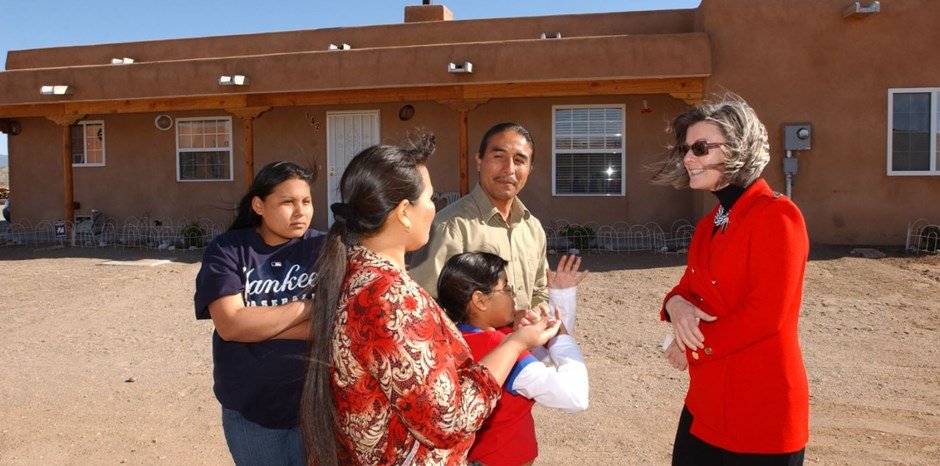One of the reasons the United States became the most prosperous nation in the history of the world can be found in the institutions created to protect individual liberty, free markets, and private property rights, all of which incentivize entrepreneurship and innovation.
Unfortunately, the prosperity that exists due to the institutions created by the Founders is not afforded to all American citizens. Burdensome regulations on reservations prevent Native Americans from partaking in the prosperity.
Native American reservations in the United States are disproportionately poverty stricken. Research suggests that these problems stem from federal oversight over Native American businesses, property, and energy development on reservations. Because of overwhelming regulation, “tribal sovereignty” is more a hollow legal concept than a meaningful policy position. The key to Native American development and tribal sovereignty is not found in more federal funding or oversight, but in policies that clarify property rights and remove transaction costs to doing business.
William F. Buckley, Jr. once said, “There is an inverse relationship between reliance on the state and self-reliance.” Native Americans are no exception. Native Americans are the most regulated demographic in the United States and not coincidentally the most impoverished.
Federal control of lands is the legacy of the outdated and racist assumption that Native Americans are incapable of managing their own lands
Of the 50 million acres of land on Native American reservations, only five percent of that land is owned privately by individuals. Another 20 percent is held in individual trusts, meaning that Native Americans can own interest in tracts of land, but the titles are retained by the Bureau of Indian Affairs (BIA), which is housed in the U.S. Department of Interior (DOI). The remaining 75 percent of tribal land is held in a trust by the BIA and the interest in the land is owned collectively by a tribe. The “owners” in these trust arrangements are not allowed to sell their ownership rights or buy land from other individuals. It should come as no surprise then that, at 26.2 percent, the Native American poverty rate is almost double that of the rest of the United States.
Federal ownership of tribal lands complicates home buying and real estate development for Native Americans.
Federal control of lands is the legacy of the outdated and racist assumption that Native Americans are incapable of managing their own lands or that their cultures are incompatible with markets. Because nearly all tribal land is managed by the federal government, everything that happens on Native American lands must wind its way through an arduous bureaucratic process. The tribes have little, if any control over those processes, which raises a substantial barrier to economic growth.
The lack of tribal autonomy creates several implications for economic development on reservations and impacts the quality of life of Native Americans on those reservations directly. Home ownership, natural resource development, and entrepreneurship on Native American lands are substantially hindered by government oversight.
Home Ownership and Real Estate Development Frustrated
Federal ownership of tribal lands complicates home buying and real estate development for Native Americans. Because lands are owned collectively, banks cannot repossess the property if an individual tribe member is unable to repay a loan secured by a land title. That makes the already complicated process of getting a mortgage even more difficult. Insufficient infrastructure discourages private developers from pursuing projects on tribal lands because of limited and poorly maintained utilities and roads.
The infrastructure issues and the rural nature of most development on reservations make the profit margins for private companies slim, leaving little reason for developers to invest in the reservations. The issues are difficult to understate. On the Navajo reservation, 32 percent of homes lack electricity, 31 percent lack plumbing, 38 percent lack running water, and 60 percent lack telephone services. According to the Navajo Tribal Utility Authority, at the current electricity hook-up rate, it would take 35 years and hundreds of millions of dollars to connect electricity service to the entire Navajo reservation.
One of the most unfortunate consequences of the institutions currently surrounding property rights on Native American Reservations is that they discourage entrepreneurship.
Because of these deterrents, the Indian Housing Authority (IHA) often finances housing development, which is a laborious process. Many Native Americans live in substandard housing conditions because of the long waiting list to get suitable IHA housing. In 2010, the US Department of Housing and Urban Development (HUD) determined that close to 543,000 Native American households have “severe housing needs,” defined as “living conditions that are overcrowded, substandard or cost-burdensome.”
In 2017, HUD concluded that “the lack of housing and infrastructure in Indian Country is severe and widespread… .”
Energy Development
In spite of the vast wealth of natural resources on tribal lands, Native Americans remain the most impoverished demographic in the United States, partly because their ability to develop those resources is limited by stringent rules on land development. The Department of Interior estimates that 15 million acres of untapped energy and mineral resources exist on reservations, accounting for approximately 30 percent of coal reserves, 50 percent of known uranium deposits, and 20 percent of oil and gas reserves in the Western US. These energy resources are valued at $1.5 trillion. Yet only 2.1 million acres are being developed for energy and minerals production.
Energy development is as controversial on Native American reservations as anywhere else in America. Reducing barriers to energy production should be done only so tribes have the freedom they’ve long deserved—to decide for themselves what to develop and where. Right now, the federal government is deciding for them because of the expensive permitting process with which individuals and companies must comply. On tribal lands, it can take years for potential energy investors to complete the required 49 steps and secure the approval of four federal agencies. In contrast, only four steps must be completed for developments on non-tribal lands.
Reducing barriers to energy production should be done only so tribes have the freedom they’ve long deserved—to decide for themselves what to develop and where
On the 2.1 million acres that already are developed on tribal lands, the government collects the payments from energy companies and pays royalties to individual Native Americans. Unfortunately, multiple court cases show that those royalties repeatedly have been mismanaged by the federal government. For example, Cobell v. Salazar was a 13-year long lawsuit that culminated with a $3.4 billion settlement paid by the government (i.e. taxpayers) to Native Americans from multiple tribes. The court ruled that the Department of Interior both failed to properly negotiate transactions on the tribe’s behalf and failed to enforce the terms and conditions included in the contracts that the DOI brokered.
The $3.4 billion settlement is not small, but it’s paltry compared to what the federal government prevents the tribes from accessing on their own lands. In fact, according to an estimate by Terry Anderson and Shawn Regan, just a 5 percent return on the available energy resources would generate an additional $75 billion dollars per year for the tribes. The government agencies involved in permitting energy developments can streamline processes by relying on Native Americans to determine where and what they want to develop.
Land Fractionation Slows Economic Development
Another aspect of land ownership that undermines economic prosperity is land fractionation from outdated federal policies. The Dawes Act of 1887 requires that when an individual Native American owns the interest in a tract of land, it must be partitioned up equally among heirs at death. After a few generations of dividing and subdividing the land, tracts are rendered next to useless because consent from a majority of owners is required to do anything with the land. In 1992, 704,562 people owned an interest in one tract of land. In just 18 years, that number nearly doubled to 1,312,391.
Fundamentally, the fractionation required by federal policies increases transaction costs for any kind of development that owners may want to pursue. Individual owners are prohibited from selling their shares unilaterally. Obtaining permission for developments from all the owners can exceed the property’s value, restricting activities like farming, business startups, and real estate development.
In 2012, the Obama Administration launched a buyback program for all fractionalized land as part of the Cobell v. Salazar settlement. Essentially, the BIA will buy the interest in fractioned land from individual Native Americans. The land then goes into a trust that the BIA controls, but the tribe owns an interest in it. Although that is a step forward, many Native Americans are justifiably skeptical of the BIA. After all, the motivation for Cobell v. Salazar was to recoup money that had been lost when transacting with the federal government. Many Native Americans are unhappy with the continued practice of retaining the land in a trust, rather than granting full control to the tribes and individual Native Americans.
The Dawes Act’s fractionation requirements should be reformed to prevent further fractionation. For example, by allowing individual families to determine how to divvy up inheritances and allowing individuals to sell their shares. Without action, the number of owners of each parcel will continue to grow, and the property’s value will decrease in kind.
Red Tape Thwarts Native American Entrepreneurship
One of the most unfortunate consequences of the institutions currently surrounding property rights on Native American Reservations is that they discourage entrepreneurship. Because federal rules tightly control businesses, limit access to capital, and make property rights obscure, Native American reservations have few entrepreneurs. A 2016 article in the Journal of Developmental Entrepreneurship concludes that the three key disincentives to entrepreneurship on reservations are: 1) poorly defined property rights, 2) limited access to financial capital, and 3) the arduous business licensing process.
Releasing tribal lands from federal trusts and transferring them into the hands of tribes and individual Native Americans would cut the red tape that blocks economic development
Clearly defined property rights are essential for encouraging entrepreneurship for multiple reasons. Recent studies have shown that developing areas, like reservations, generally have fewer entrepreneurs because people do not have formal titles to their property. Informal property rights’ regimes create what is referred to as “dead capital” because land ownership is not recognized or enforced by the legal system. Because of the absence of secure deeds and titles, potential entrepreneurs cannot collateralize their property to finance business pursuits.
Uncertainty about the process and legal requirements involved in starting new businesses discourage potential entrepreneurs. Property rights and transparent licensing processes provide clarity in financial transactions and lower the costs of doing business. They allow for reliability in negotiating property transfers and clearly define the costs and rewards of a given property transaction. For example, if a potential entrepreneur wants to open a business, but is unsure about the process, it is impossible to accurately assess the potential profitability of the idea.
Tribal Sovereignty Would Unleash the Wealth on Native American Reservations
Manny Jules, a former chief of a Canadian tribe, has led the charge in privatizing tribal lands in Canada. The tribes, or bands, face challenges to starting businesses similar to those encountered on US tribal lands. Forbes quotes him pointing out the fundamental change needed in the US as much as it is in Canada, “Markets haven’t been allowed to operate in reserve lands. We’ve been legislated out of the economy. When you don’t have individual property rights, you can’t build, you can’t be bonded, you can’t pass on wealth…businesses never get started because people can’t leverage property…We have to become part of the national and global economies.”
The federal government has legislated Native Americans into perpetual poverty.
Releasing tribal lands from federal trusts and transferring them into the hands of tribes and individual Native Americans would cut the red tape that blocks economic development, thereby unleashing prosperity on reservations. The limited access to banks, grocery stores, restaurants, utility providers, and other basic needs all would become opportunities for entrepreneurial Natives to improve their lives and those of others with them.
The history of Native American reservations makes clear that the root of the problem is federal involvement in the Indian economy, which also clarifies at least a part of the solution. Allowing greater tribal and individual sovereignty will jumpstart wealth creation by Native Americans.
The first steps towards that future can be taken by allowing owners of fractionalized lands to sell their shares without obtaining permission to do so. Such a policy change would provide those wishing to secure loans for homes or entrepreneurial activities access to capital. Likewise, federal oversight should be reduced to the levels that other US citizens experience so that it does not become a barrier to developments and that tribes can determine what is in their best interest.
The federal government has legislated Native Americans into perpetual poverty. The institutions that federal agencies designed limit opportunities to own homes, develop and invest in their property, and discourage entrepreneurs from starting businesses. Those are all essential tenets of a prosperous society. Now is the time for Native Americans to develop their own policies.
This content was originally published here.
EL 2 DE JUNIO DEL 2024 VOTA PARA MANTENER
TU LIBERTAD, LA DEMOCRACIA Y EL RESPETO A LA CONSTITUCIÓN.
VOTA POR XÓCHITL













Comentarios